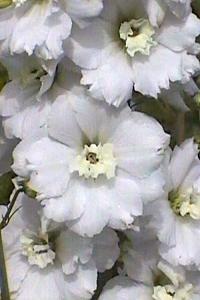 SECTIONS
SECTIONS| Return to Introduction | Return to Home Page |
Delphiniums from Seed 3Breeding delphiniums with white flowers |
SOME BASIC PRINCIPLES
The first point to be kept in mind for a delphinium with white flowers is that white is a genetically recessive colour. The consequence is that if a white flower is fertilised with pollen from a blue or purple delphinium, the resulting seeds are most likely to give plants with blue or purple flowers. To be reasonably certain that some or all of a batch of seedlings will have white flowers, the seed used should be from:
These are the two approaches we use in breeding white delphiniums. There are two situations in which the underlying assumptions are inadequate to account for the colours of seedlings from a cross that might be expected to yield white flowers:
The first situation arises when both parents carry a recessive gene associated with yellowish (cream) flowers. Some seeds may then produce plants with creamy white flowers, although these would probably just be described as white by an inexperienced observer.
The problem with white flowers that are sports is designed to trap the unwary. You can make a cross with another white flower and then find that all the resulting seedlings have unwanted coloured flowers.
Application of these principles and the problems are illustrated in the following sections.
| Return toSection Headings List |
A 'SUMMERFIELD ARIANE' CROSS IN 2002
The cross grown illustrates the first of the two approaches to breeding white delphiniums in being between two cultivars having white flowers with white eyes. 'Summerfield Ariane' has good points but one of the faults is that the sepals tend to become quilled as the florets age so that the base of a mature bloom looks rather ragged. The cultivar chosen as pollen parent is a sister plant to the cultivar 'Blackberry Ice' and has flowers with a beautiful rounded form and an almost parchment like substance to the petals. It was hoped that some seedlings would have florets more like the pollen parent than 'Ariane'.
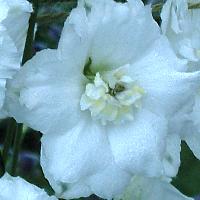 |
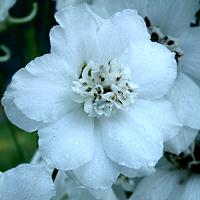 |
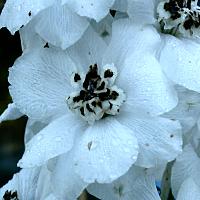 |
The first seedlings to flower were generally of an acceptable standard as garden flowers but there were some plants with florets or blooms of poor form. Florets mostly had sepals of good substance. The eye often developed an open centre that is a characteristic of 'Spindrift' descendants, as seen in the left hand picture and the picture of another of these seedlings at the top of the page.
Every year seems to produce fresh curiosities among our seedlings and in this batch of seedlings it was the strange case of the heart-shaped black blotches that developed in the eye petals of at least three seedlings. The pictures above show this for two seedlings for which the eyes were initially completely white. Blackening of white eye petals is sometimes a feature of the ageing of white delphinium flowers but this case was unlike anything we have seen previously. It will be interesting to see if the effect occurs in any of the plants next summer.
| Return to Section Headings List |
CROSSES GROWN IN 2001
Two crosses between white cultivars were grown. In one case, both parents had white flowers with white eyes and all the seedlings also had white flowers with white eyes. The second cross was between 'Blackberry Ice', a tinted white with a black eye and a white flower with white eye. In this case the flowers were white with pronounced violet tinges and most had brown or brown striped eyes.
These crosses did not yield any seedlings of outstanding merit but they emphasised the critical importance of having a well-formed and attractive eye in the flower.
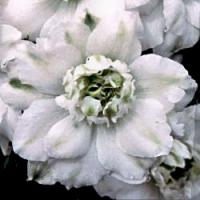 |
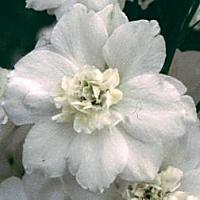 |
The two florets from sister plants shown above have a strongly protruding eye. The eye of the left hand flower is most unusual as it has something of the character of a crown with a central cushion formed by modified stamens. The regularity of the structure and the fascination of the flower was lost as it aged. The eye of the flower on the right from a sister plant was less dramatic when it first opened but aged to provide a more attractive central feature than the open-centered eye of 'Summerfield Ariane'.
It is difficult to evaluate the merit of such features because the form of flowers at the normal flowering season in June or July can be quite different from what is seen in the autumn. In July 2002, the plant that produced florets with the 'crown' structure in the eye had lost this feature , while the multi-petal eye seen in the right hand picture was also found in the July flowers.
| Return to Section Headings List |
IMPROVING ON 'LILIAN BASSETT'
A Cross grown in 2001: 'Lilian Bassett' x 'White Ruffles'
Good characteristics of delphinium 'Lilian Bassett' are the clean white flowers with a well defined black eye and the short growth of the plant when in an open situation. A bad feature is that the stem within the bloom is normally very slender and often is not sufficiently rigid to prevent the blooms from bending over. The stems develop many sideshoot that flower after the main spike is finished but again these readily bend over so that their flowers are spoiled.
Experience with 'White Ruffles', an all-white cultivar from 'Blackmore and Langdon, indicated that the stem is stiffer than that of 'Lilian Bassett', so it seemed worth crossing these cultivars to obtain plants retaining the short growth habit but with stiffer stems. 'White Ruffles' does not always have a well-formed eye and the distinction between sepals and petals is then blurred.
Lilian Bassett |
White Ruffles |
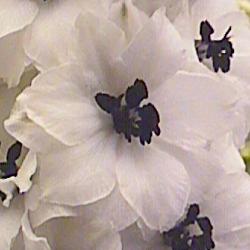 |
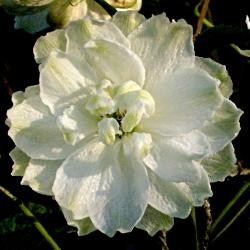 |
As was expected, most of the seedlings had white flowers although about 25% were quite feeble plants with creamy white flowers and poor yellowish leaves. This shows that 'White Ruffles' is like 'Lilian Bassett' in having a high dose of the recessive gene that results in yellowish flowers when this character is expressed. This potential for cream flowers in 'White Ruffles' is not especially apparent in early summer flowers but a small bloom that opened in October had strong greeny-yellow tinges, as seen in the picture above.
The seedling were all short and some seemed to have stiffer stems than 'Lilian Bassett'. Unfortunately, the ill-defined eye of 'White Ruffles' proved dominant. The group of four seedling florets below is a representative selection and, with such poorly formed flowers, none of these seedlings can be considered worth retaining for a further year.
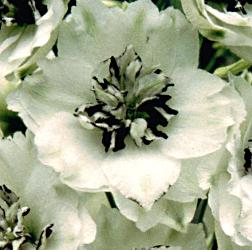 |
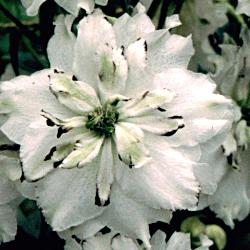 |
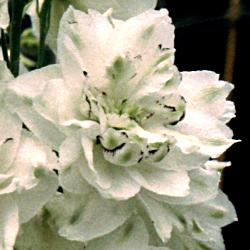 |
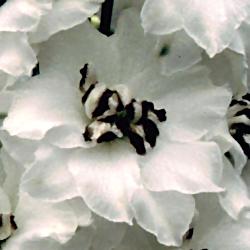 |
It is disappointing when the results of a cross are so unsatisfactory but a positive lesson is that 'White Ruffles' does not provide a route to improving on 'Lilian Bassett', so other cultivars will need to be explored as cross parents.
| Return to Section Headings List |
BREEDING OF 'SUMMERFIELD ARIANE'
The breeding of 'Summerfield Ariane illustrates the use in a cross of a parent that has coloured flowers but which also carries the recessive gene for white flowers. The seed parent was 'Spindrift', which has flowers in a fascinating mixture of pale blue with pinkish and greeny tinges. 'Spindrift' was raised by T.O. Cowan from a cross between a blue flower, 'Loch Leven', and a greeny white seedling in the pursuit of pure turquoise-blue flowers. Our experience is that white flowers occur quite frequently in seedlings from 'Spindrift'
A cross between 'Spindrift' and a creamy-white seedling from the brown-eyed white, 'Olive Poppleton', produced a number of seedlings with white flowers. One of the selected seedlings was named 'Summerfield Ariane' after several seasons during which it proved a reliable and prolific producer of good blooms.
| Spindrift | Summerfield Ariane |
|---|---|
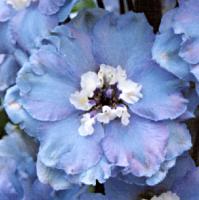 |
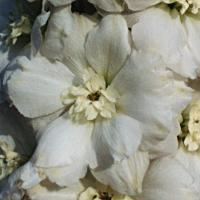 |
It is interesting to note that 'Summerfield Ariane' has many similarities to 'Spindrift' in growth habit and the form of the flowers and it is also flowers exceptionally early in the season. The plant has a relatively short leafy stem below the bloom, while the flowers have a ruffled edge and the open-centered eye that is particularly characteristic of seedlings from 'Spindrift'.
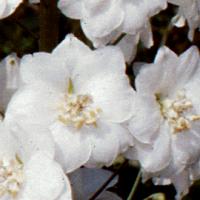 The ruffled edge of the
florets in 'Spindrift' seems to be a dominant characteristic, so
a better parent for white delphiniums with flat florets of good
form is the violet cultivar 'Emily Hawkins'. The pollen parent of
'Emily Hawkins' was 'Olive Poppleton', a white with a light brown
eye. Crossing 'Emily Hawkins' with 'Icecap', a pure white, gave
some white seedlings with light brown eyes although most were
unsatisfactory in other respects. The first of the seedlings to
flower had a regular spike and beautiful white florets shown
here, similar in form to florets of 'Emily Hawkins'.
Unfortunately this seedling did not prove to be a durable plant.
The ruffled edge of the
florets in 'Spindrift' seems to be a dominant characteristic, so
a better parent for white delphiniums with flat florets of good
form is the violet cultivar 'Emily Hawkins'. The pollen parent of
'Emily Hawkins' was 'Olive Poppleton', a white with a light brown
eye. Crossing 'Emily Hawkins' with 'Icecap', a pure white, gave
some white seedlings with light brown eyes although most were
unsatisfactory in other respects. The first of the seedlings to
flower had a regular spike and beautiful white florets shown
here, similar in form to florets of 'Emily Hawkins'.
Unfortunately this seedling did not prove to be a durable plant.
| Return to Section Headings List |
'Lilian Bassett' x 'Sandpiper'
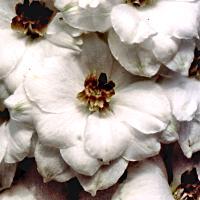 Both cultivars have white flowers with
black or dark brown eyes, so a cross between them should produce
seedlings with white flowers and coloured eyes. In making this
cross we hoped one plant among the offspring would combine the
short growth of 'Lilian Bassett' with the bloom quality of
'Sandpiper'. 'Lilian
Bassett' was used as seed parent because it is a reliable and
prolific seed producer.
Both cultivars have white flowers with
black or dark brown eyes, so a cross between them should produce
seedlings with white flowers and coloured eyes. In making this
cross we hoped one plant among the offspring would combine the
short growth of 'Lilian Bassett' with the bloom quality of
'Sandpiper'. 'Lilian
Bassett' was used as seed parent because it is a reliable and
prolific seed producer.
'Sandpiper', shown on the right, has a lovely tapered spike and florets of good form and substance. It is interesting to note that the registration of 'Sandpiper' describes this cultivar as having a 'cream' eye, when the eye is actually very dark brown in fresh florets although it bleaches to pale brown in strong sunshine.
This cross yields a high proportion of good quality white seedlings, with many having the short growth habit of 'Lilian Bassett'. However, not all the seedlings are pure whites, which illustrates a point made in the first section above. Some have creamy white flowers and yellowish foliage, which indicates that both parents are white delphiniums that also carry the unexpressed recessive gene for cream/yellowish flowers.
USING 'SILVER JUBILEE'
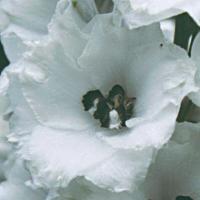 For many years, 'Silver Jubilee', has
been the only white flower with a black eye in the list of named
cultivar available from Blackmore & Langdon. For many
growers, including ourselves, it is therefore tempting to cross
this cultivar with other white delphiniums as a route to
seedlings with white flowers having intense black eyes.
For many years, 'Silver Jubilee', has
been the only white flower with a black eye in the list of named
cultivar available from Blackmore & Langdon. For many
growers, including ourselves, it is therefore tempting to cross
this cultivar with other white delphiniums as a route to
seedlings with white flowers having intense black eyes.
When we did this, the result was disappointing in that the seedlings all had mauve flowers. The reason is that 'Silver Jubilee', seen in the picture here, arose as a sport from a mauve delphinium 'Jumbo'. In crosses with other white cultivars 'Silver Jubilee' behaves like 'Jumbo' and is not genetically a white flower.
We understood why this happens only after reading about similar problems that occur in the breeding of chrysanthemums, in which mutations causing changes of flower colour occur quite frequently. The plant tissues consist of a number of layers of cells and, in a colour sport, the reproductive organs can develop from tissue that is genetically different from the cell layer responsible for the colour of sepals and petals. A crucial point for the stability of such 'sports' is that this genetic diversity of the cell layers within a single plant is preserved during vegetative propagation.
| Return to Section Headings List |
| Return to Introduction | Return to Home Page |